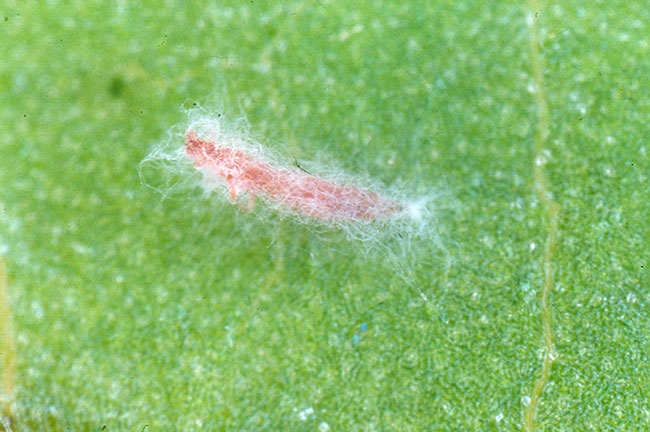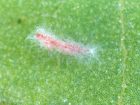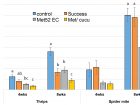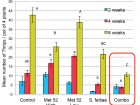
Features
Biocontrols
Inputs
The rise of microbes offers growers some important new IPM tools
In nature, insects and mites are commonly infected and killed by naturally occurring microorganisms (fungi, bacteria, viruses) and nematodes.
June 7, 2017 By Drs. Michael Brownbridge and Rose Buitenhuis
 Figure 1 - Western flower thrips infected with Beauveria bassiana.
Figure 1 - Western flower thrips infected with Beauveria bassiana. July 2017 – This is part 3 in a six-part series of articles from the Vineland Research and Innovation Centre on thrips (and other pests) integrated pest management, where we will provide practical application tips and tricks, information on new technologies and how it all fits within an overall IPM program.
Microbial biopesticides: In nature, insects and mites are commonly infected and killed by naturally occurring micro-organisms (fungi, bacteria, viruses) and nematodes. Some of these organisms have lent themselves well to commercial development and today several microbial biocontrol agents are registered for pest and disease management in greenhouse crops. These microbial biopesticides are based on bacteria (e.g., Bacillus thuringiensis, B. subtilis, B. amyloliquefaciens, B. pumilus), fungi (e.g., Beauveria bassiana, Metar-hizium brunneum/anisopliae, Isaria fumosorosea, Trichoderma harzianum, T. virens, T. viride), viruses (e.g., nucleopolyhedrosis viruses) and nematodes (e.g., Steinernema feltiae, S. carpocapsae). These are marketed under a range of product names. It is important to recognize that even though some products contain the same microbe species, e.g., B. bassiana or B. subtilis, they may show varying levels of activity against different insects or diseases. The scientific name may be the same, but specific isolates, formulation methods and product specifications may vary, affecting efficacy.
For the purpose of this article, we will focus on fungi and nematodes that are registered for control of greenhouse pests, especially thrips.
Fungi: Fungi are the predominant natural pathogens in the arthropod world. They are the only pathogens able to infect their hosts through the body wall and are pathogenic to both insects and mites.
Currently, two registered products are available in Canada: BotaniGard® (based on B. bassiana GHA strain) and Met52® (based on M. brunneum strain F52; formerly classified as M. anisopliae).
Two additional products are currently undergoing registration in Canada: Bioceres® (B. bassiana strain ANT-03; WP formulation) and PFR-97™ (based on I. fumosorosea Apopka Strain 97; WDG formulation). All are considered reduced-risk products, safe for workers and the environment, with a short Restricted Entry Interval.
Mode of action: All of the fungal products contain conidia (spores) with the exception of PFR-97 which contains blastospores. Insect (or mite) infection begins when conidia (or blastospores) come in contact and become attached to the cuticle. Conidia germinate, and penetrate the insect body wall through a combination of mechanical force and production of enzymes that digest the cuticle. The fungus then grows inside the insect body and will eventually kill the host (Figure 1). It may take several days for death to occur and symptoms are typically hard to recognize.
If external conditions are suitable, i.e. high ambient humidity, fungal mycelia will grow out of the insect body, commonly emerging from jointed areas on the legs or abdomen and giving the dead insect a typical ‘fuzzy’ appearance. Under ideal conditions, conidia form on the mycelia and can infect healthy insects that contact them. However, in reality, recycling of the fungus rarely occurs in the greenhouse.
Products: BotaniGard is available in Canada in wettable powder (BotaniGard 22WP) and emulsifiable suspension (BotaniGardES) formulations. They are registered for use against a variety of insect pests, including whiteflies, thrips and aphids.
Met52 is sold as an emulsifiable concentrate (Met52 EC). Originally, a granular formulation of Met52 was available for incorporation into growing media for thrips and black vine weevil control. The EC is very effective as a foliar spray against thrips, whiteflies, aphids and spider mites (Figure 2), or can be applied as a heavy spray to the crop substrate, infecting and killing thrips larvae entering the media to pupate. After a temporary hiatus in production of the fungus in 2016, we have been informed that the EC formulation will again be available in spring/summer 2017.
High temperatures and moisture are detrimental to fungi. To keep the conidia viable for as long as possible, follow the instructions on the label. Under less than ideal conditions, shelf life can be as short as three months. Remember, fungi are living organisms and need to be stored and handled appropriately to maintain viability and obtain the best results.
Methods of application: WP and ES/EC formulations are generally applied by spraying against foliar-feeding pests. The fungi work as a contact insecticide so thorough spray coverage is essential to obtain control. Conidia have been formulated to enable easy mixing and suspension of the materials in a spray tank. Spray mixes should be prepared in cool water and used as soon as possible. Leaving the spray tank in direct sunlight or a heated area for an extended period will kill the spores. Similarly, a mix should not be stored overnight and used the next day. Dead conidia will not infect an insect!
If using a hydraulic sprayer, spray to wet the leaves but not to the point of run-off; as with all pesticides, spraying to run-off can actually reduce the amount of active product that remains on the leaf as material may run with the leading edge of the drip and be lost or concentrated along the leaf margin. Low volume sprayers include high-pressure cold foggers and thermal foggers, collectively referred to as ‘low volume mist’ (LVM) sprayers. Although the amount of active ingredient delivered by low volume sprayers per unit area of greenhouse effectively remains the same as that applied through a high-volume system, it is delivered in a much smaller volume of water (carrier). Hydraulic sprayers commonly produce spray droplets that are ~600 µm in diameter, whereas droplets produced by LVM sprayers typically range in size from ~10-70 µm in diameter. In addition, manufacturers of low volume equipment claim that the sprays cover plant surfaces more evenly reaching areas that are usually missed (especially the underside of leaves) and reduce waste by avoiding run off.
There is a shortage of information on the utility of LVM sprayers for microbial biopesticides. Microbial biopesticides are sensitive to high temperature and pressure, factors that are integral to the transformation of product suspensions into droplets. In trials carried out at Vineland, we tested two LVM machines – the Dramm Mini AutoFog™ and the K-22 BIO Portable PulsFOG® – to assess effects of the “fogging” process (cold and thermal) on the viability of Beauveria spores.
The cold fogger had no effect on the viability of B. bassiana conidia, whereas more than 90 per cent of the conidia were killed when applied through the thermal fogger, indicating that the K-22 BIO PulsFOG is unsuitable for application of this biopesticide. Different injection nozzles are used in other PulsFOG models, though, and may be interchanged into the K-22 BIO. Use of larger nozzles could reduce the energy and heat transferred to the conidia during atomization. By avoiding exposure of conidia to potentially lethal temperatures and physical shock, can we preserve the viability of Beauveria conidia and make it feasible to apply the product via a thermal fogger? We will provide additional information on this topic in the future.
There is no limit to the number of times fungi can be applied during a season and preventive programs often incorporate regular fungal sprays. Three sequential applications at seven-day intervals are recommended when pest pressures are low, with repeat applications as pest pressures persist thereafter. Fungi can also be used in rotation with standard insecticides to obtain a quick ‘knock down’ before resuming a preventive spray regime.
For control of soil-dwelling stages of pests, e.g., pupating western flower thrips, a heavy spray-drench of Met52 EC to the growing medium is very effective. The fungi persist at infectious levels for two to four weeks in the soil, so applications do not need to be repeated on a weekly basis.
Compatibility: Although fungi can be used as stand-alone control agents, they are most effective within an IPM program where their action is complementary to other natural enemies (consult side effects guides). BotaniGard and Met52 are compatible with many beneficials on the foliage, and soil applications of Met52 are compatible with S. feltiae and soil predators. Combined applications can provide excellent control of pupating thrips (Figure 3). BotaniGard ES has a mild repellent-effect on whitefly parasitoids for a short period of time after application (24 to 48 hours) owing to volatiles released by the oil used in the formulation. Fungi are compatible with many insecticides (can even be tank-mixed with some) and are compatible with some fungicides. A pre- or post-application period ranging from two to four days may be required for some products (see BioWorks’ website for up-to-date information).
Nematodes: Several nematode species are mass-produced for commercial use. Two are commonly used in greenhouse crops: S. feltiae and S. carpocapsae. Steinernema feltiae is most frequently recommended for control of fungus gnats, thrips and leafminers.
Mode of action: Steinernema feltiae are sold in the ‘infective juvenile’ stage, the only free-living stage in the nematode’s life cycle. Nematodes move through the water film around particles in the substrate (or on the leaf), pinpointing a host along a CO2 gradient produced by the insect.
When nematodes have located a host, they enter through natural body openings. Once inside the host, they release bacteria carried in their guts and toxins produced by the bacteria kill the insect. When the insect dies, the bacteria break down the body contents allowing nematodes to feed and reproduce. Hosts typically die within two to three days following infection.
When external conditions are suitable and if the host is large enough to allow for a complete reproductive cycle, the next generation of infective juveniles leave the dead insect in search of new hosts. While nematodes have the potential to ‘recycle,’ this does not normally occur at a high or fast enough rate in the greenhouse, so repeat applications are needed to control pest populations.
Products: Steinernema feltiae is available under various trade names and sold in a variety of formulations, e.g., gels, clay-based, or on inert carriers such as sponges. When purchased, products should be stored at 5 C – do not freeze. They can be stored for two to three months but gradually lose viability after this period. There are some simple ways in which growers can quickly check the viability of their material; these will be demonstrated in the video accompanying the online version of this article.
Methods of application: There are a few key points to remember when using nematodes, similar to those mentioned above for fungi. Details are provided on the greenhouseIPM.org website that outlines essential steps in the mixing and application of these natural enemies to ensure they remain healthy and viable, and reach their target in the best possible shape for insect infection to occur. Nematodes can be applied by hydraulic sprayer (less than 300 psi), targeting a heavy spray/drench (sprench) to the substrate. Nematodes have also been applied through overhead spray booms and by drip irrigation. If using drip irrigation, it is important to ensure that nematodes do not settle in the lines or get too hot during application, and that viable nematodes are delivered in high enough numbers along the full length of the drip line.
Generally speaking, nematodes are considered soil organisms and foliage becomes a hostile environment for them. Although foliar applications may infect some thrips larvae, research shows that thrips are most effectively targeted during the pupal phase, in the growing medium. Consequently, nematode applications typically target the top of the soil. Most applications are made from above the crop canopy. In the early stage of plant growth, the foliage is sparse and sprays can easily penetrate it to reach the soil. As the plants grow and the canopy becomes denser, more nematodes are intercepted by the foliage and fewer reach the soil, resulting in decreased efficacy. At this point, many growers rely on other biocontrol agents for thrips control.
Compatibility: Nematodes are compatible with many insecticides, although growers should refer to side effects guides for the most current product information. As indicated above, nematodes are compatible with fungal products and can even be tank mixed with BotaniGard and Met52 EC. They also function well with foliar predators and parasitoids and are compatible with soil predators (e.g., Stratiolaelaps, Dalotia), although some may snack on the nematodes in the absence of other prey or food. As always, nematodes are best used preventatively. In crops such as chrysanthemum, many growers start their applications during propagation to keep pests like thrips in check. Used correctly, and following a few simple guidelines to keep nematodes happy, they will provide a reliable and consistent level of control within your IPM program.
Click here for the accompanying video for this feature.
We appreciate feedback, so if you have any suggestions for topics or comments, please let us know (Rose.Buitenhuis@vinelandresearch.com; Michael.Brownbridge@vinelandresearch.com).
Print this page


